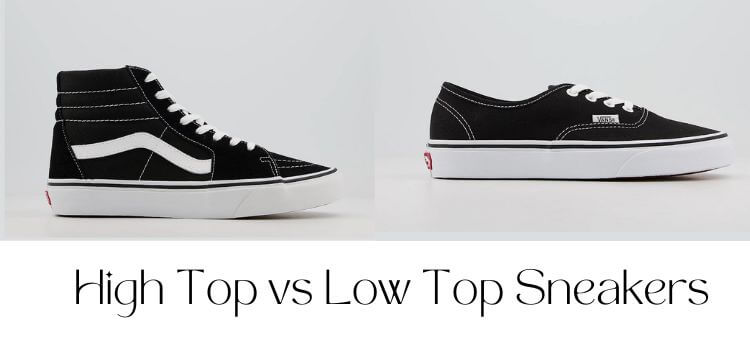
Sneakers have been a staple in the world of fashion for decades, evolving from a simple sports accessory to a must-have piece in everyone’s wardrobe. Whether you’re aiming for comfort or trying to make a bold fashion statement, sneakers offer unmatched versatility. One of the hottest debates in sneaker culture is the battle between high-top and low-top sneakers. Which style is better for you? Let’s break down the differences in terms of fashion, function, and personal style.
What Are High Top Sneakers?
High-top sneakers extend above the ankle, offering more coverage and support. Traditionally, these sneakers were designed for basketball players to prevent injuries by providing better ankle support during the game. Today, they’ve become a fashion icon, often associated with street style and retro-inspired outfits.
Benefits of High-Top Sneakers
Ankle Support: Due to their extended height, high tops offer better ankle stability compared to low tops. This makes them ideal for activities like skateboarding or even walking long distances.
Fashion Appeal: High tops often serve as a statement piece in an outfit. They can be dressed in joggers, skinny jeans, or shorts for a casual yet polished style.
Retro Vibe: High tops evoke a vintage or old-school aesthetic, especially styles inspired by iconic 80s and 90s fashion. Brands like Converse and Nike Air Jordan have been instrumental in making high tops a timeless classic.
Drawbacks of High-Top Sneakers
Bulkier Design: High tops tend to be bulkier, which can sometimes limit their versatility, especially when paired with certain types of pants or slimmer-fitting outfits.
Limited Breathability: Since they cover more of the ankle and foot, high tops may not be the best choice for hot weather or prolonged wear.
What Are Low Top Sneakers?
Low-top sneakers, on the other hand, sit below the ankle and are generally lighter and more versatile. They are often associated with more casual, everyday wear but can still be styled for a variety of occasions.
Benefits of Low-Top Sneakers
Versatility: Pairing low tops with jeans, shorts, skirts, or dresses creates a versatile look for any outfit. Their slim profile makes them easy to incorporate into different fashion styles.
Lightweight Design: Since they don’t cover the ankle, low tops tend to be lighter and more comfortable for all-day wear, especially in warmer climates.
Breathability: Thanks to their open design, low tops allow for better airflow, keeping your feet cooler in hot weather.
Drawbacks of Low-Top Sneakers
Lack of Ankle Support: While they’re more breathable and lightweight, low tops don’t provide as much support for the ankle, which could be a downside for those who are prone to injuries.
Less of a Statement: While low tops can still be stylish, they often don’t stand out as much as high tops. If you’re looking to make a bold style impression, high tops could be the ideal choice.
High Top vs Low Top Sneakers: Which is Better for Fashion?
When it comes to fashion, both high-top and low-top sneakers have their place, but your choice largely depends on the look you’re aiming for.
High Tops for a Bold Statement
If you’re into making bold fashion moves, high tops are typically the way to go. They add height and bulk to your outfit, Making them the centerpiece of your outfit. High tops pair well with:
Skinny jeans: The slim fit of the jeans balances the bulkiness of the high tops, creating a stylish contrast.
Joggers: For a more streetwear-inspired look, joggers and high tops go hand-in-hand.
Shorts: In the summer, pairing high tops with shorts gives you a cool, laid-back vibe while still staying on-trend.
Low Tops for a Clean and Casual Look
On the flip side, low tops offer a more subtle and refined look. Their sleek design makes them ideal for casual outfits or even smart-casual settings. Some fashion pairings for low tops include:
Chinos or tailored pants: For a more polished casual look, pair your low tops with chinos or slim-cut trousers.
Skirts and dresses: Low-top sneakers are also perfect for adding a sporty twist to feminine outfits, such as pairing them with skirts or dresses.
Denim shorts or jeans: You can never go wrong with classic denim and low tops, whether you’re rocking skinny jeans or cut-off shorts.
How to Style High-Top Sneakers
When styling high-top sneakers, it’s important to balance the bulkiness of the shoe with the rest of your outfit. Here are a few tips for achieving the perfect look:
How to Style Low-Top Sneakers
Styling low-top sneakers is generally easier due to their slim and versatile design. Here are some ways to incorporate them into your wardrobe:
Sneaker Culture and the High Top vs Low Top Debate
The choice between high tops and low tops often boils down to more than just fashion—it’s also about your connection to sneaker culture. High tops have a more niche, streetwear appeal, often associated with basketball, skateboarding, and retro aesthetics. Low tops, on the other hand, are more widely embraced as a universal casual shoe, making them perfect for both everyday wear and subtle styling.
Fashion enthusiasts and sneakerheads often own both styles, using each for different purposes depending on the occasion or outfit. If you’re building a versatile sneaker collection, it’s worth having a mix of both high-top and low-top sneakers to cover all your fashion bases.
Conclusion: Choosing the Right Sneakers for You
In the battle of high-top vs low-top sneakers, there’s no definitive winner—both styles have their unique advantages. If you prioritize ankle support and want a shoe that makes a bold statement, high tops might be your go-to option. On the other hand, if you’re after something more versatile and lightweight, low tops could be the better choice for your wardrobe.
Ultimately, the best sneaker for you will depend on your personal style, the outfits you typically wear, and the occasions you plan to rock them. Whether you opt for high tops or low tops, both styles are timeless, ensuring you stay fashionable no matter the season.